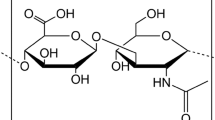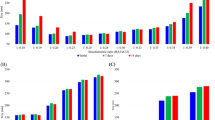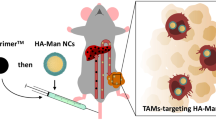ABSTRACT
Purpose
Hyaluronic acid-ceramide (HACE)-based nanoparticles (NPs) were developed for the targeted delivery of doxorubicin (DOX), and their antitumor efficacy for melanoma was evaluated.
Methods
DOX-loaded HACE-based self-assembled NPs were prepared and their physicochemical properties were characterized. The in vitro cytotoxicity of HACE was measured using an MTS-based assay. The cellular uptake efficiency of DOX into mouse melanoma B16F10 cells was assessed by confocal laser scanning microscopy and flow cytometry. Tumor growth and body weight were monitored after the intratumoral and intravenous injection of DOX-loaded NPs into a B16F10 tumor-bearing mouse model.
Results
DOX-loaded NPs, with a mean diameter of ~110 nm, a narrow size distribution, and high drug entrapment efficiency, were prepared. A sustained DOX release pattern was shown, and drug release was enhanced at pH 5.5 compared with pH 7.4. The cytotoxicity of HACE to B16F10 cells was negligible. It was assumed that DOX was taken up into the B16F10 cells through receptor-mediated endocytosis. A significant inhibitory effect was observed on tumor growth, without any serious changes in body weight, after the injection of DOX-loaded NPs into the B16F10 tumor-bearing mouse model.
Conclusions
DOX-loaded HACE-based NPs were successfully developed and their antitumor efficacy against B16F10 tumors was demonstrated.







Similar content being viewed by others
REFERENCES
Momparler RL, Karon M, Siegel SE, Avila F. Effect of adriamycin on DNA, RNA, and protein synthesis in cell-free systems and intact cells. Cancer Res. 1976;36(8):2891–5.
Laginha KM, Verwoert S, Charrois GJR, Allen TM. Determination of doxorubicin levels in whole tumor and tumor nuclei in murine breast cancer tumors. Clin Cancer Res. 2005;11(19):6944–9.
Von Hoff DD, Layard MW, Basa P, Davis HL, Von Hoff AL, Rozencweig M, et al. Risk factors for doxorubicin-induced congestive heart failure. Ann Intern Med. 1979;91(5):710–7.
Kawashima Y, Yamamoto H, Takeuchi H, Kuno Y. Mucoadhesive DL-lactide/glycolide copolymer nanospheres coated with chitosan to improve oral delivery of elcatonin. Pharm Dev Technol. 2000;5(1):77–85.
Choi KY, Chung H, Min KH, Yoon HY, Kim K, Park JH, et al. Self-assembled hyaluronic acid nanoparticles for active tumor targeting. Biomaterials. 2010;31(1):106–14.
Li N, Wang J, Yang X, Li L. Novel nanogels as drug delivery systems for poorly soluble anticancer drugs. Colloids Surf B Biointerfaces. 2011;83(2):237–44.
Chen MC, Tsai HW, Liu CT, Peng SF, Lai WY, Chen SJ, et al. A nanoscale drug-entrapment strategy for hydrogel-based systems for the delivery of poorly soluble drugs. Biomaterials. 2009;30(11):2102–11.
Mahmud A, Xiong X, Lavasanifar A. Development of novel polymeric micellar drug conjugates and nano-containers with hydrolyzable core structure for doxorubicin delivery. Eur J Pharm Biopharm. 2008;69(3):923–34.
Greish K. Enhanced permeability and retention of macromolecular drugs in solid tumors: A royal gate for targeted anticancer nanomedicines. J Drug Target. 2007;15(7–8):457–64.
Fukumori Y, Ichikawa H. Nanoparticles for cancer therapy and diagnosis. Adv Powder Technol. 2006;17(1):1–28.
Iinuma H, Maruyama K, Okinaga K, Sasaki K, Sekine T, Ishida O, et al. Intracellular targeting therapy of cisplatin-encapsulated transferrin-polyethylene glycol liposome on peritoneal dissemination of gastric cancer. Int J Cancer. 2002;99(1):130–7.
Kobayashi T, Ishida T, Okada Y, Ise S, Harashima H, Kiwada H. Effect of transferrin receptor-targeted liposomal doxorubicin in P-glycoprotein-mediated drug resistant tumor cells. Int J Pharm. 2007;329(1–2):94–102.
Dharap SS, Wang Y, Chandna P, Khandare JJ, Qiu B, Gunaseelan S, et al. Tumor-specific targeting of an anticancer drug delivery system by LHRH peptide. Proc Natl Acad Sci U S A. 2005;102(36):12962–7.
Laurent TC. The chemistry, biology and medical applications of hyaluronan and its derivatives. London: Portland; 1998.
Prestwich G, Marecak D, Marecek J, Vercruysse K, Ziebell M. Controlled chemical modification of hyaluronic acid: synthesis, applications, and biodegradation of hydrazide derivatives. J Control Release. 1998;53(1–3):93–103.
Price R, Berry M, Navsaria H. Hyaluronic acid: the scientific and clinical evidence. J Plastic Reconstr Aesthet Surg. 2007;60(10):1110–9.
Culty M, Shizari M, Thompson E, Underhill C. Binding and degradation of hyaluronan by human breast cancer cell lines expressing different forms of CD44: correlation with invasive potential. J Cell Physiol. 1994;160(2):275–86.
Akima K, Ito H, Iwata Y, Matsuo K, Watari N, Yanagi M, et al. Evaluation of antitumor activities of hyaluronate binding antitumor drugs: synthesis, characterization and antitumor activity. J Drug Target. 1996;4(1):1–8.
He M, Zhao Z, Yin L, Tang C, Yin C. Hyaluronic acid coated poly(butyl cyanoacrylate) nanoparticles as anticancer drug carriers. Int J Pharm. 2009;373(1–2):165–73.
Saddoughi SA, Song P, Ogretmen B. Roles of bioactive sphingolipids in cancer biology and therapeutics. In: Quinn PJ, Wang X, editors. Lipids in health and disease. Netherlands: Springer; 2008. p. 413–40.
Cho HJ, Yoon HY, Koo H, Ko SH, Shim JS, Lee JH, et al. Self-assembled nanoparticles based on hyaluronic acid-ceramide (HA-CE) and Pluronic® for tumor-targeted delivery of docetaxel. Biomaterials. 2011;32(29):7181–90.
Cho HJ, Yoon IS, Yoon HY, Koo H, Jin YJ, Ko SH, et al. Polyethylene glycol-conjugated hyaluronic acid-ceramide self-assembled nanoparticles for targeted delivery of doxorubicin. Biomaterials. 2012;33(4):1190–200.
Choi KY, Yoon HY, Kim JH, Bae SM, Park RW, Kang YM, et al. Smart nanocarrier based on PEGylated hyaluronic acid for cancer therapy. ACS Nano. 2011;5(11):8591–9.
Chang JE, Shim WS, Yang SG, Kwak EY, Chong S, Kim DD, et al. Liver cancer targeting of doxorubicin with reduced distribution to the heart using hematoporphyrin-modified albumin nanoparticles in rats. Pharm Res. 2012;29(3):795–805.
Cai S, Thati S, Bagby TR, Diab HM, Davies NM, Cohen MS, et al. Localized doxorubicin chemotherapy with a biopolymeric nanocarrier improves survival and reduces toxicity in xenografts of human breast cancer. J Control Release. 2010;146(2):212–8.
Luo Y, Bernshaw NJ, Lu ZR, Kopecek J, Prestwich GD. Targeted delivery of doxorubicin by HPMA copolymer-hyaluronan bioconjugates. Pharm Res. 2002;19(4):396–402.
Kim DH, An EJ, Kim J, Han SH, Kim JW, Oh SG, et al. Fabrication and characterization of pseudo-ceramide-based liposomal membranes. Colloids Surf B Biointerfaces. 2009;73(2):207–11.
Liao YH, Jones SA, Forbes B, Martin GP, Brown MB. Hyaluronan: pharmaceutical characterization and drug delivery. Drug Deliv. 2005;12(6):327–42.
Ma Y, Tang Y, Billingham NC, Armes SP, Lewis AL, Lloyd AW, et al. Well-defined biocompatible block copolymers via atom transfer radical polymerization of 2-methacryloyloxyethyl phosphorylcholine in protic media. Macromolecules. 2003;36(10):3475–84.
Lavasanifar A, Samuel J, Kwon GS. Micelles self-assembled from poly(ethylene oxide)-block-poly(N-hexyl stearate-aspartamide) by a solvent evaporation method: effect on the solubilization and haemolytic activity of amphotericin B. J Control Release. 2001;77(1–2):155–60.
Yokoyama M. Drug targeting with nano-sized carrier systems. J Artif Organs. 2005;8(2):77–84.
Liu D, Mori A, Huang L. Role of liposome size and RES blockade in controlling biodistribution and tumor uptake of GM1-containing liposomes. Biochim Biophys Acta. 1992;1104(1):95–101.
Gaucher G, Dufresne MH, Sant VP, Kang N, Maysinger D, Leroux JC. Block copolymer micelles: preparation, characterization and application in drug delivery. J Control Release. 2005;109(1–3):169–88.
Choi YK, Lee DW, Yong CS, Choi HG, Bronich TK, Kim JO. Biostable poly(ethylene oxide)-b-poly(methacrylic acid) micelles for pH-triggered release of doxorubicin. J Pharm Invest. 2011;41(2):111–5.
Nukolova NV, Oberoi HS, Cohen SM, Kabanov AV, Bronich TK. Folate-decorated nanogels for targeted therapy of ovarian cancer. Biomaterials. 2011;32(23):5417–26.
Prabaharan M, Grailer JJ, Pilla S, Steeber DA, Gong S. Folate-conjugated amphiphilic hyperbranched block copolymers based on Boltorn® H40, poly(l-lactide) and poly(ethylene glycol) for tumor-targeted drug delivery. Biomaterials. 2009;30(16):3009–19.
Liu H, Farrell S, Uhrich K. Drug release characteristics of unimolecular polymeric micelles. J Control Release. 2000;68(2):167–74.
Fritze A, Hens F, Kimpfler A, Schubert R, Peschka-Süss R. Remote loading of doxorubicin into liposomes driven by a transmembrane phosphate gradient. Biochim Biophys Acta. 2006;1758(10):1633–40.
Eliaz RE, Nir S, Marty C, Szoka Jr FC. Determination and modeling of kinetics of cancer cell killing by doxorubicin and doxorubicin encapsulated in targeted liposomes. Cancer Res. 2004;64(2):711–8.
Kim EJ, Shim G, Kim K, Kwon IC, Oh YK, Shim CK. Hyaluronic acid complexed to biodegradable poly L-arginine for targeted delivery of siRNAs. J Gene Med. 2009;11(9):791–803.
Yang X, Grailer JJ, Rowland IJ, Javadi A, Hurley SA, Matson VZ, et al. Multifunctional stable and pH-responsive polymer vesicles formed by heterofunctional triblock copolymer for targeted anticancer drug delivery and ultrasensitive MR Imaging. ACS Nano. 2010;4(11):6805–17.
Godden D, Brennan PA, Milne J. Update on melanoma: the present position. Br J Oral Maxillofac Surg. 2010;48(8):575–8.
Author information
Authors and Affiliations
Corresponding authors
Electronic supplementary material
Below is the link to the electronic supplementary material.
ESM 1
(DOC 129 kb)
Rights and permissions
About this article
Cite this article
Jin, YJ., Termsarasab, U., Ko, SH. et al. Hyaluronic Acid Derivative-Based Self-Assembled Nanoparticles for the Treatment of Melanoma. Pharm Res 29, 3443–3454 (2012). https://doi.org/10.1007/s11095-012-0839-9
Received:
Accepted:
Published:
Issue Date:
DOI: https://doi.org/10.1007/s11095-012-0839-9




